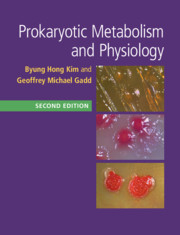Book contents
- Prokaryotic Metabolism and Physiology
- Prokaryotic Metabolism and Physiology
- Copyright page
- Dedication
- Contents in brief
- Contents
- Preface for the second edition
- Preface for the first edition
- Chapter 1 Introduction to prokaryotic metabolism and physiology
- Chapter 2 Composition and structure of prokaryotic cells
- Chapter 3 Membrane transport – nutrient uptake and protein excretion
- Chapter 4 Glycolysis
- Chapter 5 Tricarboxylic acid (TCA) cycle, electron transport and oxidative phosphorylation
- Chapter 6 Biosynthesis and growth
- Chapter 7 Heterotrophic metabolism on substrates other than glucose
- Chapter 8 Anaerobic fermentation
- Chapter 9 Anaerobic respiration
- Chapter 10 Chemolithotrophy
- Chapter 11 Photosynthesis
- Chapter 12 Metabolic regulation
- Chapter 13 Energy, environment and microbial survival
- Index
- References
Chapter 2 - Composition and structure of prokaryotic cells
Published online by Cambridge University Press: 04 May 2019
- Prokaryotic Metabolism and Physiology
- Prokaryotic Metabolism and Physiology
- Copyright page
- Dedication
- Contents in brief
- Contents
- Preface for the second edition
- Preface for the first edition
- Chapter 1 Introduction to prokaryotic metabolism and physiology
- Chapter 2 Composition and structure of prokaryotic cells
- Chapter 3 Membrane transport – nutrient uptake and protein excretion
- Chapter 4 Glycolysis
- Chapter 5 Tricarboxylic acid (TCA) cycle, electron transport and oxidative phosphorylation
- Chapter 6 Biosynthesis and growth
- Chapter 7 Heterotrophic metabolism on substrates other than glucose
- Chapter 8 Anaerobic fermentation
- Chapter 9 Anaerobic respiration
- Chapter 10 Chemolithotrophy
- Chapter 11 Photosynthesis
- Chapter 12 Metabolic regulation
- Chapter 13 Energy, environment and microbial survival
- Index
- References
- Type
- Chapter
- Information
- Prokaryotic Metabolism and Physiology , pp. 5 - 30Publisher: Cambridge University PressPrint publication year: 2019



